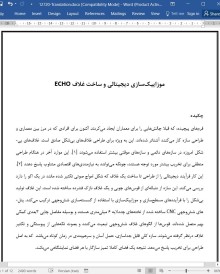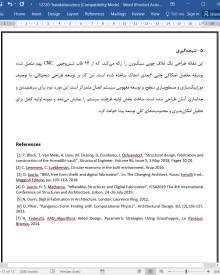
دانلود مقاله موزاییک سازی دیجیتالی و ساخت غلاف ECHO
چکیده
فرم های پیچیده، که قبلا چالش هایی را برای معماران ایجاد می کردند اکنون برای افرادی که در مرز بین معماری و طراحی سازه کار می کنند آشنا تر شده اند. این به ویژه برای طراحی غلاف های بی شکل صادق است. غلاف های بی شکل امروزه در سازه های دائمی و سازه های موقتی بیشتر استفاده می شوند [3]. این موارد آخر در هنگام طراحی منطقی برای تخریب بیشتر مورد توجه هستند، چونکه می توانند به نیازمندی های اقتصادی متناوب پاسخ دهند [2]. این کار فرآیند دیجیتالی را از طراحی تا ساخت یک غلاف که شکل امواج صوتی تکثیر شده مانند در یک اکو را دارد بررسی می کند. این سازه از دنباله ای از قوس های چوبی و یک غلاف نازک فشرده ساخته شده است. این غلاف تولید بی شکل را با فرآیندهای مسطح سازی و موزاییک سازی با استفاده از گسسته سازی شش وجهی ترکیب می کند. پنل های شش-وجهی CNC ساخته شده از تخته های چندلایه 6 میلی متری هستند و بوسیله مفاصل چاپی 3بعدی کمکی بهم متصل شده اند. قوس ها از الگوهای غلاف شش وجهی تبعیت می کنند و بصوت تکه هایی از پیوستگی و تکثیر غلاف درنظر گرفته می شوند. سازه کلی قابل جداسازی، حمل آسان و سرهم بندی در زمان کوتاه می باشد که به اصل طراحی برای تخریب پاسخ می دهد. نتیجه یک فضای کاملا تمیز سازگار با هر فضای نمایشگاهی می باشد.
1-مقدمه
در حال حاضر، اشکال بی شکل و پیچیده بخش عظیمی از راه حل های معماری را شامل می شوند [3]. پروژه های تاثیرگذار انجام شده در سراسر جهان بوسیله معماران و مهندسان برجسته گواه یک شیوه جدید طراحی هستند. فناوری های جدید مربوط به طراحی و ساخت در حال فراهم کردن تغییرات قابل توجه در معماری و آزادی کامل در بیان هنر می باشند [4]. پیشرفت حاضر ناشی از چندین عامل است ولی اولین عامل کلیدی بدون شک توسعه روش-های نوآورانه متناظر با ابزارهای دیجیتالی سرراست است که بر هر جنبه از فرآیند طراحی، از مفهوم تا ساخت تاثیر می گذارد. از طریق استفاده از تکنیک های نوآورانه اول در طراحی و سپس ساخت، تولید یک جریان کاری بهینه که نیازمندی های ویژه ای را در هر فاز طراحی برآورده کند امکان پذیر می باشد. مدل سازی پارامتری شامل تمام جنبه های طراحی با ایجاد یک ارتباط قوی در فرآیند است. سازگاری با تکنیک ساخت دیجیتالی مدرک دیگری از توانایی های بی شمار این روش جدید می باشد [5].
5- نتیجه گیری
این مقاله طراحی یک غلاف چوبی سبک وزن را ارائه می کند، که از 94 قاب شش وجهی CNC بهم متصل شده بوسیله مفاصل اصکاکی چاپی 3بعدی ادهاک ساخته شده است. این کار بر توسعه طراحی دیجیتالی، با توصیف موزاییک سازی و مسطح سازی سطح، و توسعه مفهومی سیستم اتصال متمرکز است. این مورد دوم برای سرهم بندی و جداسازی آسان طراحی شده است. ساخت بخش اولیه ظرفیت سیستم را نمایش می دهد و نمونه اولیه کامل برای تحلیل امکان پذیری و محدودیت های کلی توسعه پیدا خواهد کرد.
Abstract
Complex forms, that in history have always been challenges for architects are now becoming familiar to people working at the edge between architecture and structural design. This is, in particular, true for free form shells design. Free form shells are today undergoing a wider adoption for both permanent structures as well as temporary structures [1]. These last are of particular interest, when they are conceived according to a logic of design for deconstruction, since they can respond to circular economy requirements [2]. This work explores the digital process from design to manufacturing of a shell that has the shape of sounds waves replicating like in an Echo. The structure is made of a sequence of wooden arches and a compact thin shell. The shell combines free form generation with planarization and tessellation processes, using hexagonal discretization. The hexagonal panels are CNC fabricated from 6 mm plywood and are connected together by ad hoc 3D printed joints. The arches follow the hexagonal shell patterns and are conceived as slices of shell continuity and replication. The overall structure is demountable, easy to transport and capable to be reassembled in short time, responding to the principle of design for deconstruction. The result is a neat clean space adapt to any exposition space.
1. Introduction
In the contemporary scenario complex and freeform shapes represent a large portion of architectural solutions [3]. Impressive projects throughout the world carried out by important architects and engineers are evidence of a new way of designing. New technologies regarding the design and the fabrication are providing significant changes in architecture and total freedom in artistic expression [4]. This rising presence is due to multiple factors but firstly one of the key factors lies undoubtedly in the development of innovative methodologies associated with straightforward digital tools that affect each aspect of the design process, from the concept to the fabrication. Through the use of innovative techniques in the design first and then in the fabrication, it is possible to generate an optimized workflow that meets specific requirements in each design phase. Parametric modelling is involving all the aspects of the design creating a strong connection within the process. The interoperability with digital fabrication techniques is another demonstration of the countless potentialities that this new approach presents [5].
5. Conclusion
This paper presents the design of a lightweight wooden shell, that is made of 94 CNC hexagonal panels connected together by ad-hoc 3D printed friction joints. The work focuses on the development of the digital design, explaining tessellation and planarization of the surface, and the conceptual development of the connection system. This last has been designed to allow easy assembly and disassembly. The fabrication of a first portion demonstrates the capacity of the system, and a full prototype will be developed to analyse full feasibility and limitations.
چکیده
1-مقدمه
2-مفهوم و روش کلی
2-1 طراحی و مدل سازی پارامتری
2-2 موزاییک سازی سطوح
2-3 مسطح سازی
3- اتصالات
4- ساخت
5- نتیجه گیری
منابع
Abstract
1. Introduction
2. Concept and overall methodology
2.1 Parametric Design and Modelling
2.2 Tessellation of Surfaces
2.3 Planarization
3. Connections
4. Fabrication
5. Conclusion
References
- اصل مقاله انگلیسی با فرمت ورد (word) با قابلیت ویرایش
- ترجمه فارسی مقاله با فرمت ورد (word) با قابلیت ویرایش، بدون آرم سایت ای ترجمه
- ترجمه فارسی مقاله با فرمت pdf، بدون آرم سایت ای ترجمه



